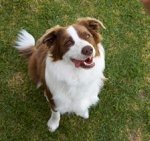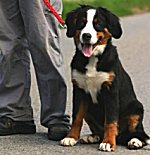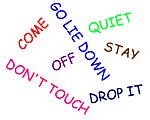Kerry Blue Terriers: What's Good About 'Em, What's Bad About 'Em
Kerry Blue Terrier temperament, personality, training, behavior, pros and cons, advice, and information, by Michele Welton, Dog Trainer, Behavioral Consultant, Author of 15 Dog Books
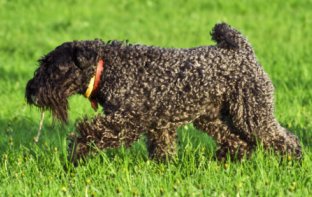
The Kerry Blue Terrier is extraordinarily bright and full of life. He has a high energy level, is always ready to play, and wants to be wherever you are. This sounds great, and it can be – but it does have its downsides.
You cannot leave a Kerry Blue Terrier alone all day, or stick him in the back yard and expect him to be passive and content. These intelligent dogs insist on being a full-fledged member of your family and cannot just be shunted aside. When bored or ignored, Kerries (like many other breeds, by the way) are likely to get into a world of mischief.
Other important-to-know characteristics of the Kerry Blue Terrier are his pride, his sensitivity, a tendency toward moodiness, and his strong sense of justice. Taken together, this means the Kerry Blue doesn't meekly accept teasing, unfairness, or rough handling.
That kind of sensitivity means that when you're training him, you can't push him too far. And yet, if you don't demonstrate firm, consistent leadership, a Kerry Blue Terrier will walk over you.
The Kerry may be one of the smartest breeds in dogdom, but that definitely doesn't mean instant obedience. Unless you establish yourself as in charge, a Kerry can be headstrong, taking clever advantage of those who indulge him.
With this complex temperament, this is not a good breed for a first-time or casual owner.
Toward strangers, the Kerry Blue Terrier may be friendly or reserved, and even the friendly ones are sensibly protective. Some lines and individuals are more wary, and some are overprotective. Socialization is imperative to develop a stable attitude.
A Kerry Blue Terrier is not always the best choice for multi-pet households. He may not go looking for a fight, but he certainly won't walk away from one, and he can have a high prey drive with cats, birds, and other small animals.
If you want a dog who...
- Is medium-sized, athletic, and agile
- Has a soft, wavy coat that doesn't shed much
- Is very smart and perceptive
- Makes a keen watchdog
A Kerry Blue Terrier may be right for you.
If you don't want to deal with...
- The dynamic terrier temperament (see full description below)
- Providing enough exercise and activities to keep them busy
- Rowdiness and exuberant jumping, especially when young
- Suspiciousness toward strangers when not socialized enough
- Aggression toward other animals – chasing instincts
- Strong-willed mind of his own, requiring a confident owner who can take charge
- Barking
- Regular brushing and clipping
- Waiting lists (hard to find) and a high price tag
A Kerry Blue Terrier may not be right for you.
 |
Dog Breed Traits – Which Traits Are Right For You? In this brand new series, I'll help you decide which dog breed traits would best suit you and your family, your home and yard, and your lifestyle, so you can choose the best dog breed for your family. |
Keep in mind that the inheritance of temperament is less predictable than the inheritance of physical traits such as size or shedding. Temperament and behavior are also shaped by raising and training.
FREE eBooks by Michele Welton
![]() "Respect Training for Puppies" and "Teach Your Dog 100 English Words" are free step by step guides to teaching your pup to be calm and well-behaved.
"Respect Training for Puppies" and "Teach Your Dog 100 English Words" are free step by step guides to teaching your pup to be calm and well-behaved.
![]() "11 Things You Must Do Right To Keep Your Dog Healthy and Happy" is a free guide to keeping your dog mentally, physically, and emotionally happy and healthy so you can enjoy a longer lifetime of companionship.
"11 Things You Must Do Right To Keep Your Dog Healthy and Happy" is a free guide to keeping your dog mentally, physically, and emotionally happy and healthy so you can enjoy a longer lifetime of companionship.

- You can avoid some negative traits by choosing an ADULT dog from an animal shelter or rescue group. With an adult dog, you can easily see what you're getting, and plenty of adult Kerries have already proven themselves not to have negative characteristics.
- If you want a puppy, you can avoid some negative traits by choosing the right breeder and the right puppy.
More traits and characteristics of the Kerry Blue Terrier
If I was considering a Kerry Blue Terrier, I would be most concerned about...
- The dynamic terrier temperament. Most terrier breeds are remarkably similar. The same words are used over and over – quick to bark, quick to chase, lively, bossy, feisty, scrappy, clever, independent, stubborn, persistent, impulsive, intense.
Kerry Blue Terriers must be taught at an early age that they are not the rulers of the world. The toughness that makes them suited to killing vermin can frustrate you when you try to teach them anything. Terriers can be stubborn and bossy and will make you prove that you can make them do things. You must show them, through absolute consistency, that you mean what you say. Follow my free online training programs.
- Potential barking. Kerries are often too quick to sound the alarm at every new sight and sound. You have to be equally quick to stop them. But that can be difficult unless you have established the right relationship with your Kerry Blue Terrier, where you are the leader and he is the follower.
- Potential animal aggression. Most Kerry Blue Terriers are dominant or aggressive toward other dogs. Most have strong instincts to chase and seize small fleeing creatures. This can make for conflict if you own a cat. It may be much worse than that if you own a pet rabbit or hamster!
- Lots of coat care. Kerry Blue Terriers don't shed a lot, but they require frequent brushing, plus clipping and trimming every few months. The shorter you clip the coat, the easier it is to care for.
- Fence security. All of the terrier breeds can be clever escape artists who will go over or under fences in search of adventure. Kerry Blue Terriers are athletic jumpers; you need higher fences than you might imagine for their size. You may also need to sink wire into the ground along the fence line to thwart digging. Don't have a fenced yard? Don't try to keep a Kerry Blue with no fenced yard. These dogs will take off after anything that runs.
- Defensive reactions. If you need to physically chastise a terrier, and you go beyond what THEY believe is a fair correction, terriers (as a group) are more likely than other breeds to growl or snap. As an obedience instructor, I'm always extra careful when putting my hands on any terrier for a correction.
I do not recommend Kerry Blue Terriers around small children. Many terriers will not tolerate any nonsense from little life forms whom they consider to be below themselves in importance. Many terriers are quick to react to teasing, and even to the normal clumsiness that comes with small children (accidental squeezing of their ears or pulling of whiskers or stepping on their paw). Many terriers are possessive of their food and toys and will defend these from all comers.
- Finding one. Not many Kerry Blue Terrier puppies are born each year in the United States. You'll probably need to go on a waiting list.
My best-selling books – now available FREE on my website
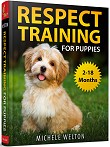 Respect Training For Puppies: 30 seconds to a calm, polite, well-behaved puppy is for puppies 2 to 18 months old. Your puppy will learn the 21 skills that all family dogs need to know. Click here to read for free.
Respect Training For Puppies: 30 seconds to a calm, polite, well-behaved puppy is for puppies 2 to 18 months old. Your puppy will learn the 21 skills that all family dogs need to know. Click here to read for free. Teach Your Dog 100 English Words is a unique Vocabulary and Respect Training Program that will teach your adult dog to listen to you and do what you say. Click here to read for free.
Teach Your Dog 100 English Words is a unique Vocabulary and Respect Training Program that will teach your adult dog to listen to you and do what you say. Click here to read for free. 11 Things You Must Do Right To Keep Your Dog Healthy and Happy helps your dog live a longer, healthier life. Get my honest advice about all 11 Things before you bring home your new puppy, because some mistakes with early health care cannot be undone. Click here to read for free.
11 Things You Must Do Right To Keep Your Dog Healthy and Happy helps your dog live a longer, healthier life. Get my honest advice about all 11 Things before you bring home your new puppy, because some mistakes with early health care cannot be undone. Click here to read for free.Related posts you might enjoy



